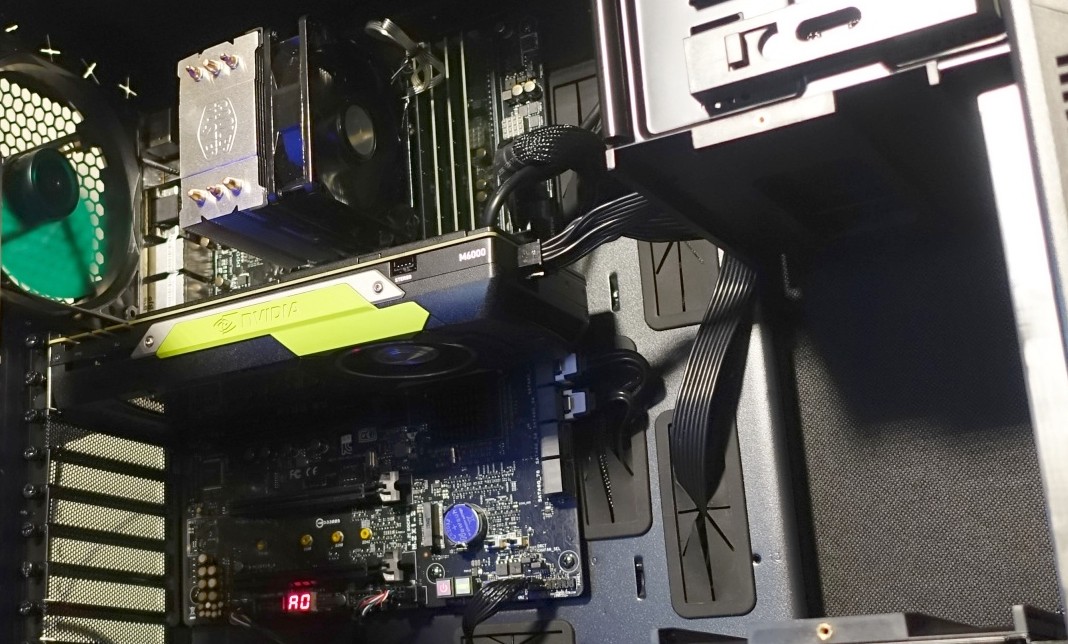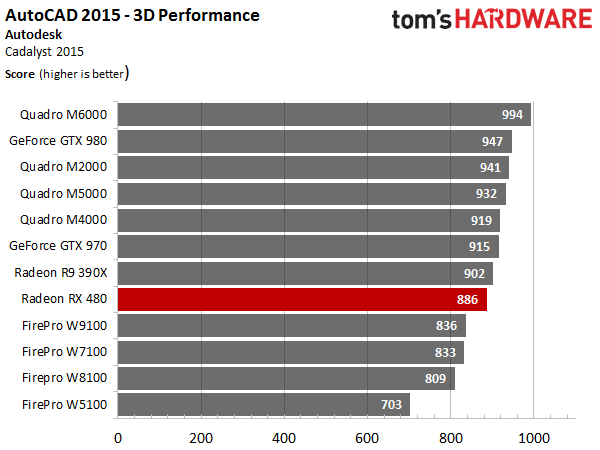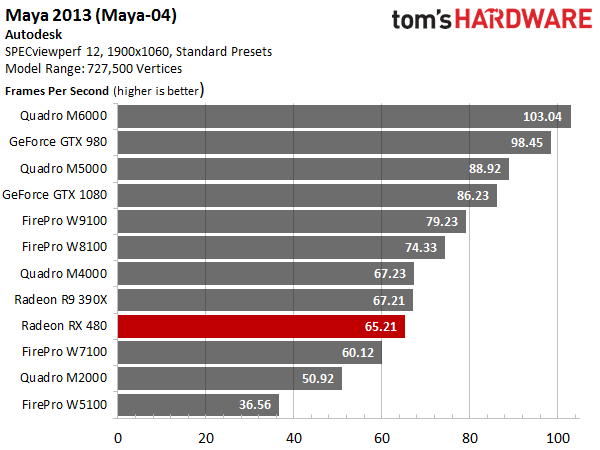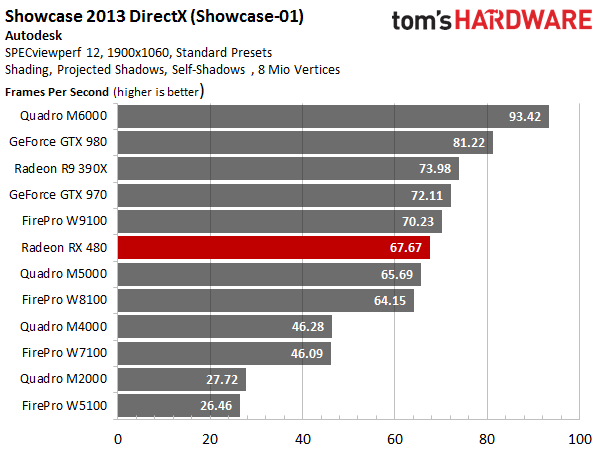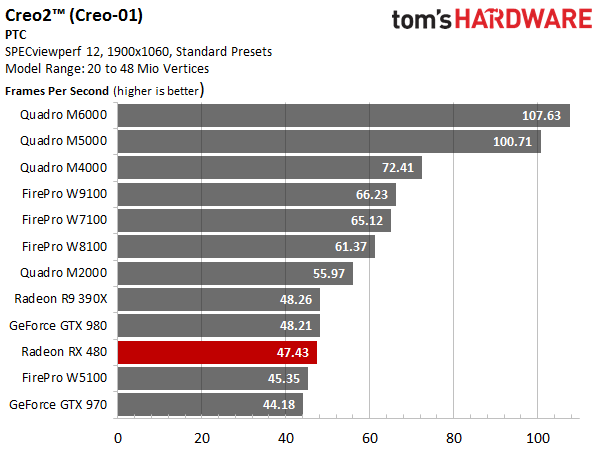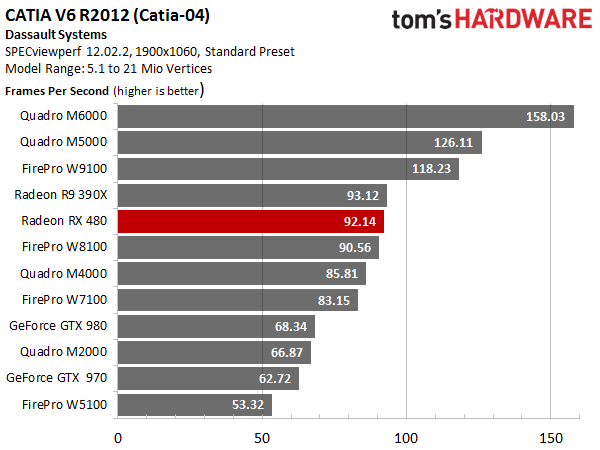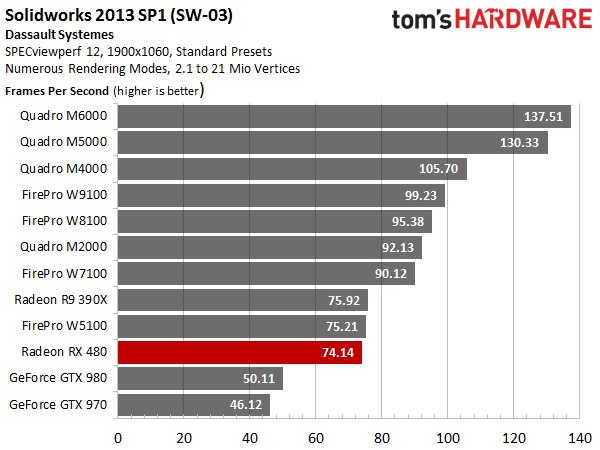AMD Radeon RX 480 8GB Review
Professional Application Results
Test System
Our German team developed a “crossover” workstation based on professional-class hardware. The CPU is a stock 3.7GHz Intel Xeon E3-1280 v5, which is the fastest Skylake-based Xeon E3. Because the system is fairly new, running recently-updated drivers, don't compare these results to numbers in our older stories.
As we know, many professional applications require certified hardware and workstation graphics cards. However, these days, companies like Autodesk use DirectX instead of OpenGL. This means that there are some workstation-class apps that run well on desktop graphics hardware for a lot less money. The following benchmarks provide a good overview of what works and what doesn’t.
| Tom's Hardware Crossover Workstation | |
|---|---|
| Test System | Intel Xeon E3-1280 v5 at 3.7GHz 4x 4GB Kingston DDR4-2133 ECC Asus P10 WS 2x Samsung SM863 (3D V-NAND) Seagate Constellation Server HDD Windows 10 Enterprise (All Updates) |
| Drivers | Catalyst Pro 15.301.2601Crimson 16.6.2 (Beta, Press Drivers)Quadro ODE 368.39 WHQL (ODE Drivers)GeForce 368.39 WHQL |
AutoCAD 3D Performance
It’s interesting to see a lot of similar-looking results in this benchmark. AMD’s Radeon RX 480 ends up right behind the R9 390X, represented by MSI's factory-overclocked R9 390X Gaming 8G.
In any case, all of the cards in our chart are bottlenecked by the Skylake-based Xeon processor. This is due to AutoCAD’s dependence on host processing IPC and the fact that it doesn’t scale very well with additional cores.
Maya 2013
From here on out, we're using the newest version of SPECviewperf12, a standard benchmark that includes a number of common professional applications and corresponding workloads. The current drivers provide some benefits to AMD cards, though the FirePro boards fare best. In contrast, all of Nvidia’s cards benefit.
Showcase 2013
Showcase 2013 is another DirectX title. The Radeon R9 390X enjoys a more substantial lead this time, and the GeForce GTX 970 ends up way ahead as well. It’s also notable that AMD's Radeon RX 480 loses to the FirePro W9100, which is just an R9 290X running at lower clock rates. At least the new card bests the FirePro W8100, the workstation version of AMD's R9 290.
Creo 2
This professional application usually doesn’t play well with consumer graphics cards. We decided to give it a try anyway. The results are as expected: AMD’s Radeon R9 390X and Nvidia’s GeForce GTX 980 lead the other desktop boards, while the GeForce GTX 970 gets left in the dust.
Get Tom's Hardware's best news and in-depth reviews, straight to your inbox.
Catia V6 R2012
A similar picture emerges in our Catia benchmark, though AMD's desktop-class boards do outrun Nvidia's.
SolidWorks 2013
FirePro- and Quadro-specific driver optimizations massively affect the finishing order in our SolidWorks test. The GeForce boards in particular perform much worse than Nvidia's professional cards. Then again, why would anyone need to buy a professional graphics card if this wasn't the case?
Bottom Line
Generally speaking, AMD’s Radeon RX 480 falls in line behind the R9 390X at roughly the performance level of a factory-overclocked R9 390. Nvidia's equivalent cards win some tests and lose others, depending on the application in question. We do really like the gains provided by AMD's new Catalyst Pro, which posts double-digit improvements over the older driver in some cases.
MORE: Best Graphics Cards
Current page: Professional Application Results
Prev Page Rise Of The Tomb Raider, The Division & The Witcher 3 Next Page Power Consumption Results-
chaosmassive this card will be my replacement of HD 7770 card for sure !Reply
thanks for the reviews, though power consumption from PCI slot is real concern here
-
asukafan2001 Seems like a decent card for what it is and what its target market is. Based off where the 1070 and 1080 fall in though i cant help but feel the 1060 which is targeted for the fall might make things uncomfortable for th 480. Nice to see amd working on power efficency though. That has always been a weakspot for them.Reply -
JeanLuc I can't help but think you need to revist this. The AOTS benchmark don't look right, the 480 is behind the 390, 390X and GTX980 in DX12.........I know this card is mid range and all that but it is 14nm with a revised chip design, surely it should be ahead of the last generation mid range cards even if it's by just a small amount.Reply
Edit: I stand corrected. Just looked at Anandtech and there results confirm what Toms is reporting. -
Oranthal Wow all the hype and it didn't deliver on any of it. Yes its an improvement but a marginal one and the supply is non existent. So its a paper launch as well. I was hoping this would be the solution to my 1440p 144hz freesync setup. Really disappointed, then again nothing lives up to online hype now. Nvidia's offerings hit the performance numbers we wanted but are insanely expensive. So I will keep waiting to see if drivers and oc's helps this card out or hope the 490 delivers.Reply
Edit: The cards are 100% available on newegg, I guess it took them until 9:30 to have them show up. I am still completely let down and hoping the partner cards and new drivers deliver on some performance gains. I guess its my fault for believing the hype that AMD could produce the same jump in the low to mid tier that Nvidia did for the high end. -
envy14tpe All that hype and finally the release....ahhh. We now have competition in the market place. The 960 and 970 have a good contender. Let's just hope price stays low as AMD doesn't play Nvidia's limited supply game.Reply
In Taiwan (where I am). There is one listing today selling the Gigabyte for $315usd. Prices need to get worked out. At that price I can get a 970.
-
rmpumper So basically AMD caught up to nvidia's now obsolete 9xx series? So much for the hype, though not unusual for AMD.Reply
